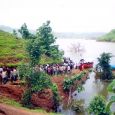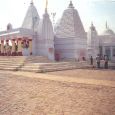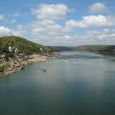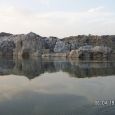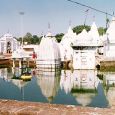Narmada
Advertisement
The Narmada (Devanagari: नर्मदा, Gujarati: નર્મદા) ,also called Rewa is a river in central India and the fifth largest river in the Indian subcontinent. It forms the traditional boundary between North India and South India and flows westwards over a length of 1,312 km (815.2 mi) before draining through the Gulf of Cambey (Khambat) into the Arabian Sea, 30 km (18.6 mi) west of Bharuch city of Gujarat.[1] It is one of only three major rivers in peninsular India that runs from east to west (largest west flowing river) along with the Tapti River and the Mahi River. It is the only river in India that flows in a rift valley flowing west between the Satpura and Vindhya ranges although the Tapti River and Mahi River also flow through rift valleys but between different ranges. It flows through the states of Madhya Pradesh (1,077 km (669.2 mi)), Maharashtra, (74 km (46.0 mi))– (35 km (21.7 mi)) border between Madhya Pradesh and Maharashtra and (39 km (24.2 mi) border between Madhya Pradesh and Gujarat and in Gujarat (161 km (100.0 mi)).
The Periplus Maris Erythraei (c. 80 CE) calls it the Nammadus,[3] and the British Raj called it the Nerbudda or Narbada.[4] Narmadā is a Sanskrit word meaning "the Giver of Pleasure".
Origin of Narmada River
The place of origin of Narmada River is an open pool known as Narmada Kund. There are various beautiful temples around Narmada Kund such as Sri Shuryanarayan temple, Siddheswar Mahadev temple, Annapurna temple, Shri Ram Janki temple, Shiva temple, Kartikey temple, Vangeshwar Mahadev temple, Eleven Rudra temple, Guru Gorakhnath temple, Durga temple, Shiv Pariwar, Sri Radha Krishna temple, etc. The spot of origin of River Narmada is regarded as a sacred ground. Basically, Narmada Kund is an open pond that is lying at the initial point of this river. Several temples dedicated to many Gods and Goddesses surround Narmada Kund. Tourists from far and wide come to visit this place.
History of Narmada River
The history of Narmada River is closely associated with the place Amarkantak and Narmada Kund. In Indian Puranas, Ramayana, Mahabharata, Shatapatha Brahmana and Vashishtha samhita, Amarkantak and its rivers have been mentioned. However, there is hardly mention of Narmada River in Vedic literature. History of near about 3000 years has remained in dark after the era of Mahabharata. Nearly 6000 years back, Suryavanshi King Mandhata founded a town in Riksh Parvat`s valley and named it Mandhata. Queen of Purukutsa, son of Mandhatri, gave the name Narmada to the river.
Geography of Narmada River
Geography of Narmada River includes Narmada Valley. The narrow valley of the Narmada lies below the Vindhyachal scarps. Narmada River flows across this narrow valley and this valley covers the southern region of Dhar District`s Manawar tehsil and the southeastern part of Kukshi tehsil of the district. The width of the valley is 15 to 30 kilometers. The height of the river ranges from 275 metres to 150 metres. The height varies in northern part of Manawar tehsil to that of the southwest low plain of Nisarpur. In the western side of the Narmada Valley, Khalghat and Bakaner lie. It is wider and comparatively fertile. Towards westwards, Narmada valley comprises several hills that are the originating point of a number of streams. These streams join Narmada River resulting in few stretches of alluvium deposit. Valleys of Narmada River are historically as well as economically significant. History states that Chalukya emperor Pulakeshin II defeated emperor Harshavardhan of Kannauj on the banks of Narmada River.
Tributaries of Narmada River
At Hoshangabad, Narmada River has some striking ghats constructed on its banks. Its longest tributary is the Tawa River. It joins Narmada River at Bandra Bhan in Hoshangabad District, Madhya Pradesh. This river broadens out in Bharuch District after traversing through Maharashtra and Madhya Pradesh. Below Bharuch city it forms a 20 kilometre wide estuary where it enters the Gulf of Cambay. The water of the river is used not only for feeding the drought prone areas of states of Gujarat and Madhya Pradesh, but also for navigation as well.
Course of Narmada River
Narmada River begins with its starting point at a very small tank called Narmada Kund situated at AmarkantakThe course of Narmada River begins with its starting point at a very small tank called Narmada Kund situated on Amarkantak hill in Shahdol district of eastern Madhya Pradesh. The river flows down from the Amarkantak hill range at the Kapildhara falls over a tall cliff and roams down the hills flowing through a distorted course and crossing the rocks and islands up to the ruined palace of Ramnagar. The river traverses further between Ramnagar and Mandla in the southeast direction. Course of River Narmada is relatively straight with deep water and there are very less rocky hindrances.
Geology of Narmada River
The geology of Narmada River valley says it a graben. A graben means a layered block of the earth`s crust that dropped down comparatively to the blocks on either side due to ancient spreading of the earth`s crust. Narmada River`s watershed consists of northern slopes of Satpura mountain ranges, as well as the vertical southern slope of the Vindhya mountain Range. The Narmada valley is regarded as very important for paleontological studies.
Religious Significance of Narmada River
The religious significance of Narmada River lies in its origin. The river is one of the most sacred of the five holy rivers of India; the other four sacred rivers of India are Ganga, Yamuna, Godavari and Kaveri. People have this belief that a dip in Narmada River washes away all the sins. There are references of Narmada River in Ramayana, Mahabharata and Indian Puranas. Rewa Khand of Vayu Purana and of Skanda Purana is entirely dedicated to the story of origin and importance of Narmada River.
Forests and Sanctuaries along Narmada River
Along the Narmada River, there are various forests and sanctuaries. Some of the best hardwood forests of India are also found along this river. The teak trees along this river are much older as compared to the ones in the Himalayas.
Anthropological Sites along Narmada River
The anthropological sites along Narmada River are considered of great interest among the tourists as well as the historians. The extensive caves of Bhimbhetka are located in a dyke structure of the Narmada valley at about 45 km northeast of Bhopal. These caves lie between Bhopal and Hoshangabad highway and depict pre-historic rock shelter paintings. These paintings are considered a priceless chronicle in the history of India, which are sculpted on the summit of the Vindhyan heights.
Narmada River development was planned for keeping the banks and water of the river clean and usable for resource needs. The early background and dispute of River Narmada have emerged with many advanced plans for the development of the basin. Explorations for using the Narmada waters had began around the time of independence, when Central Waterways, Irrigation and Navigation Commission or the CWINC came up with several storage schemes.
The navigation along the River Narmada is at its best nowadays. The main tributaries of River Narmada like Hallon, Banjar, Barna River and Tawa are the main source of water, irrigation and other resource based activities in the central India.
Information not available


